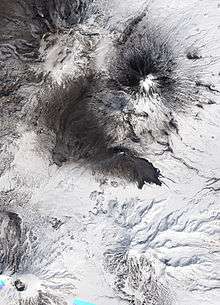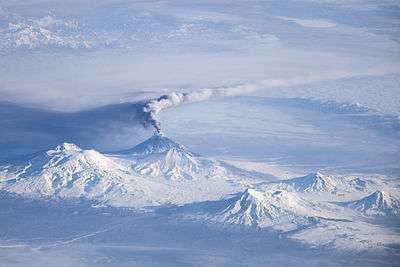Bezymianny
| Bezymianny | |
|---|---|
 Kamchatka volcanoes: Klyuchevskaya Sopka (up), Bezymianny (down), both in activity, and the Kamen (middle). | |
| Highest point | |
| Elevation | 2,882 m (9,455 ft) |
| Coordinates | 55°58′42″N 160°35′12″E / 55.97833°N 160.58667°E |
| Geography | |
| Location | Kamchatka, Russia |
| Geology | |
| Mountain type | Stratovolcano, Somma volcano |
| Last eruption | 2010–2013[1] |

Bezymianny (Russian: Безымянный, meaning unnamed) is an active stratovolcano in Kamchatka, Russia. Bezymianny volcano had been considered extinct until 1955. In 1955, there was a dramatic eruption. This eruption, similar to that of Mount St. Helens in 1980, produced a large horseshoe-shaped crater that was formed by collapse of the summit and an associated lateral blast. Subsequent episodic but ongoing lava dome growth, accompanied by intermittent explosive activity and pyroclastic flows, has largely filled the 1956 crater. The most recent eruption of lava flows occurred in February 2013.[2] The modern Bezymianny volcano, much smaller than its massive neighbors Kamen and Kliuchevskoi, was formed about 4700 years ago over a late-Pleistocene lava-dome complex and an ancestral volcano that was built between about 11,000–7000 years ago. There have been three periods of intensified activity in the past 3000 years.

View
See also
References
- ↑ "Bezymianny (Eruptive History)". Global Volcanism Program. Smithsonian Institution. Retrieved 26 February 2016.
- ↑ "VONA/KVERT Weekly Information Release 05-2013 - Kamchatkan and Northern Kuriles Volcanic Activity - January 31, 2013, 23:31 UTC (February 01, 2013, 11:31 KST)". Kamchatka Volcanic Eruption Response Team. 1 February 2013. Retrieved 26 February 2016.
- ↑ NASA - Activity at Kliuchevskoi
External links
- "Bezymianny". Global Volcanism Program. Smithsonian Institution.
- Bezymianny Volcano live webcam
- Holocene Volcanoes in Kamchatka / Bezymianny
- Google Maps satellite image
- Information about Bezymyanny (Russian)
- For its eruptive history, go to http://www.volcano.si.edu/volcano.cfm?vn=300250 and click on its tab marked "Eruptive History".
